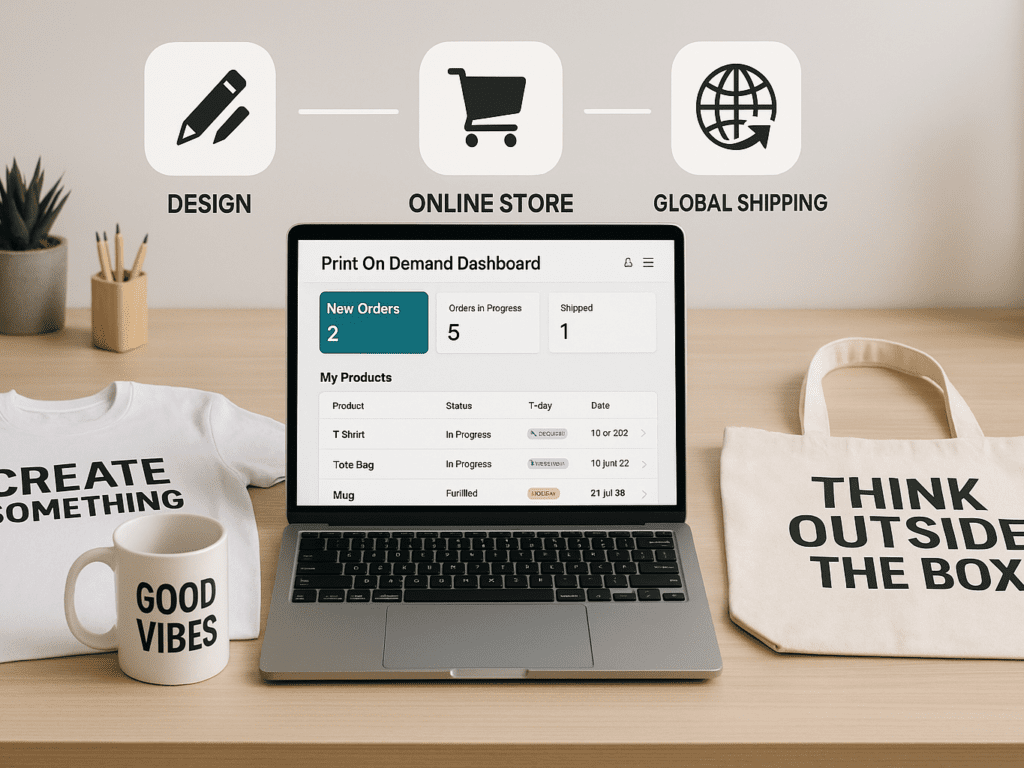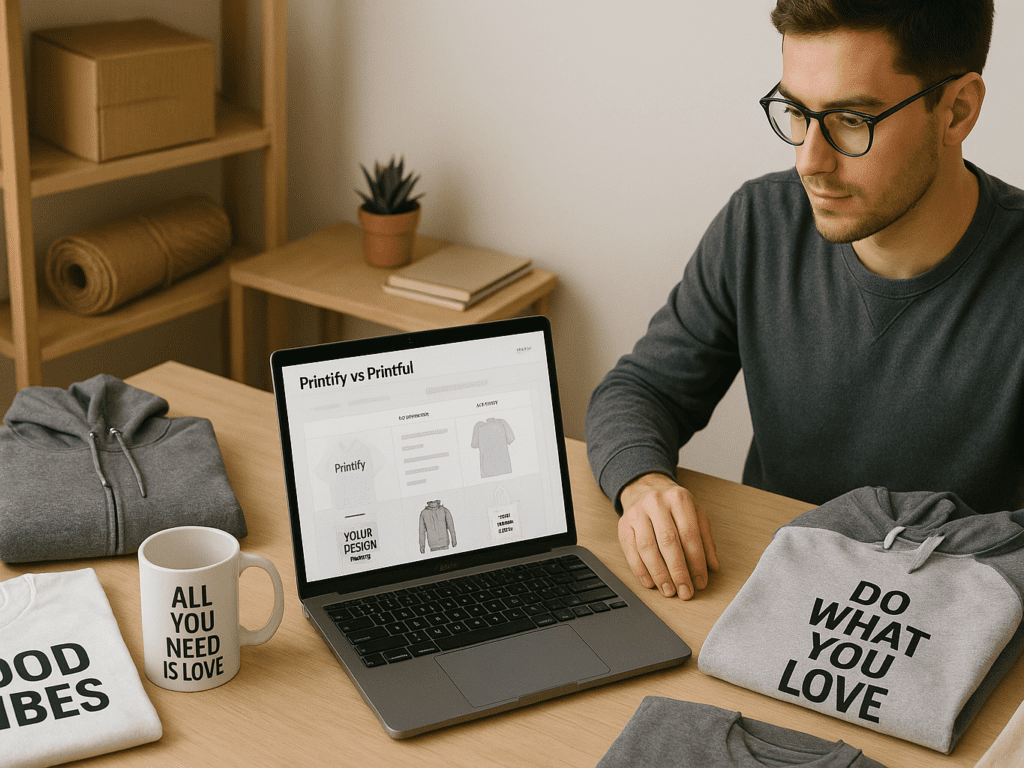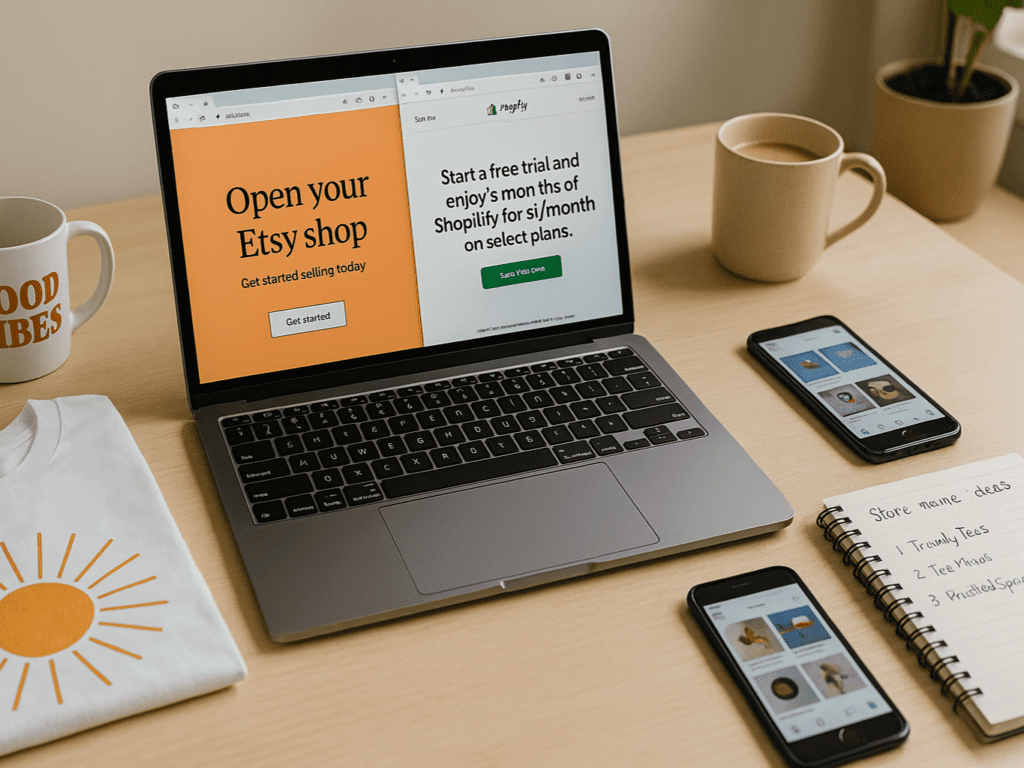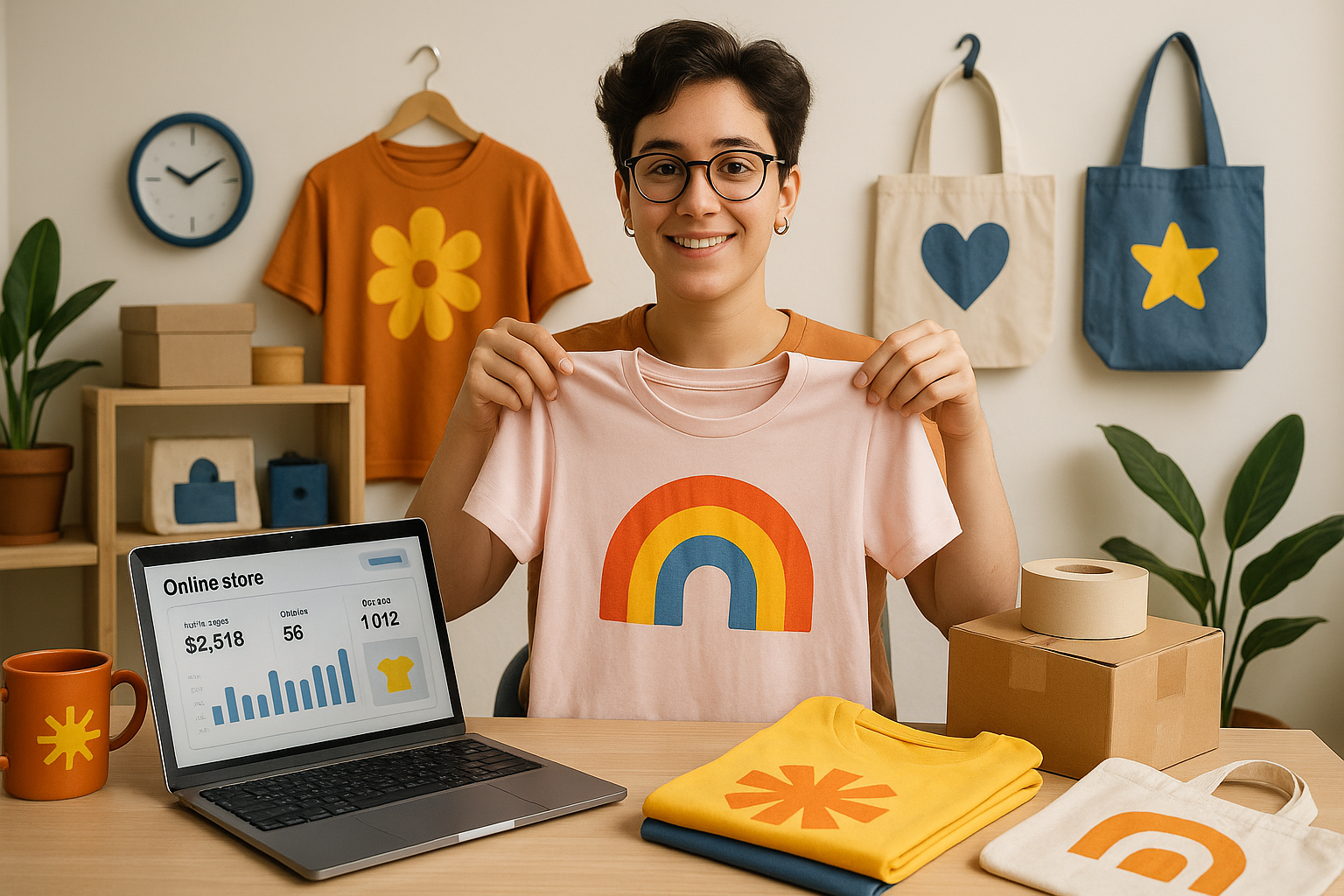According to a report by Printful, the global print-on-demand business market is projected to reach an impressive $48.4 billion by 2032.
The numbers make sense once you see the benefits. Starting a print-on-demand business lets you skip inventory management and puts your energy into design and marketing. It creates custom products only after customers order them, significantly reducing your financial risk.
The print-on-demand business model shines, especially when you have creative talent. Artists, influencers, and entrepreneurs targeting specific markets can launch easily through platforms like Printify with minimal costs. You can learn to start a print-on-demand business without spending money by using free tools and connecting with popular marketplaces like Etsy or Shopify.
Smart sellers earn a substantial income as time goes on. Their earnings change based on their chosen niche, design quality, and pricing strategy. Studies show that online shoppers value free shipping six times more than fast shipping, which can help your new business stand out.
This guide will show you the steps from being a beginner to making your first sale. Let’s dive in!
Understand the print-on-demand business Model.

Print-on-demand business is one of the easiest ways to start an ecommerce venture today. This innovative strategy removes many common roadblocks that traditional retail presents. Let’s look at how it works and why it could be your best way to start an online business.
1. What is a print-on-demand business?
According to Printify [a print-on-demand platform], businesses follow a straightforward idea: products are created only after a customer orders. This method, known as POD, links your creative designs with physical products. You don’t have to handle any production yourself.
POD works like a dropshipping model where you team up with suppliers who oversee the production process. Your POD partner prints your designs on products, packs them, and ships them straight to your customers when they buy from your store. Everything happens under your brand name, which gives your buyers a smooth experience.
As explained by Printful [a leading print-on-demand service], the best part about this business model is that you never need to buy or store inventory upfront. Your job is to create designs and market your products while your POD partner handles all the manufacturing details. You only pay for products after customers have bought them, which removes the usual retail risks.
2. How the POD model works with no inventory
A print-on-demand business follows a simple path that cuts out many typical business hassles, like inventory management, upfront costs, and shipping logistics.
- Design creation: You create original, eye-catching designs or artwork that reflect your brand and can be printed on various physical products.
- Store setup: Build a professional online store using platforms like Shopify or Etsy to showcase and sell your custom-designed print-on-demand products.
- Integration: Connect your online store seamlessly with a POD provider like Printful or Printify to automate order fulfillment and production processes.
- Product listing: Upload your designs, write detailed product descriptions, choose mockups, and publish listings that attract and inform potential customers effectively.
- Order processing: When customers place an order, it’s automatically sent to your print-on-demand partner for handling, saving you manual effort.
- Production and fulfillment: Your POD partner prints, packs, and ships each item directly to the customer on your behalf.
This smooth process creates an automatic fulfillment system that runs itself after setup. You can run your business anywhere without the Internet, making it perfect for location-free work.
Your print-on-demand business lets you try different product ideas without any money risk. Nothing gets made until someone buys it, so you can test various designs, products, and prices to find what your target audience likes best.
3. Why POD is ideal for beginners
Starting a print-on-demand business with no money has several significant advantages for newcomers:
The money needed to start is much lower than that of traditional businesses. You don’t have to buy printing equipment, rent warehouse space, or stock inventory. Many POD services, like Printify, let you sign up for free and give you design tools so that you can start with almost no money.
These platforms are perfect for beginners. They come with easy-to-use tools and clear guides that show you each step. You can create and list products without any design background or technical know-how.
Risk levels are much lower than in regular business ventures. No inventory means no worries about unsold products. It creates a safe space for you to learn and try new things.
Print-on-demand businesses can grow fast. You can add more products as your sales grow without buying new equipment. Your POD partner handles increased production while you focus on growing your business.
Most POD services ship worldwide, which means your new business can reach customers everywhere. This global reach helps you find customers far beyond your local area.
Low startup costs, simple operations, small risks, and worldwide reach make print-on-demand an excellent choice for new entrepreneurs who want to test their ideas in the market.
Find a Profitable Niche with Low Competition
The right niche is vital to your print-on-demand business success. You’ll have a better chance to connect with specific audiences who want your products by avoiding saturated markets and finding profitable yet underserved niches.
1. Use Google Trends and social media to spot trends.
According to MPS Commerce [an eCommerce solutions provider], print-on-demand industry success largely depends on identifying emerging interests before they become mainstream. Google Trends emerges as a powerful free tool that shows how popular specific topics or products are over time. Research indicates it lets you explore search volume and track changing trend patterns for key phrases.
Google Trends works best when you:
- Start with broad terms related to your interests
- Look at seasonal patterns to spot cyclical changes
- Check the “Related Topics” and “Related Queries” columns to find connected niches
- Compare geographic data to target regions where people want your products most
Social media platforms are goldmines for spotting trends. Instagram, Pinterest, and TikTok help you see what catches on with potential customers. TikTok’s largest audience is in the US and consists mainly of Gen Z users. In contrast, Facebook’s primary audience ranges between 25 and 34 years old. Regularly monitoring these platforms helps you spot potential print-on-demand business ideas before market saturation.
2. Verify niche demand with keyword tools.
Market demand verification through keyword research follows trend spotting. Tools like Google Keyword Planner, Ahrefs, and Ubersuggest provide search volumes and competition levels data.
Your verification process should:
- Start with general terms related to print-on-demand products
- Move toward more specific long-tail keywords
- Search for keywords with good volume but lower competition
- Notice related search terms that might reveal untapped niches
For instance, see how “eco-friendly workout t-shirts for women” might offer better chances than “graphic t-shirts,” a specific niche with lower competition but dedicated buyers. This strategy helps you find market blind spots that competitors don’t deal with.
3. Avoid broad markets and focus on specific audiences.
Selling to everyone usually means reaching nobody effectively. A laser focus on specific segments gives your print-on-demand business a unique market position. This targeted approach creates several benefits:
Specific niches encourage stronger customer connections. Products created for clearly defined audiences like hobby enthusiasts, professionals in particular fields, or people with specific values help develop deeper relationships with customers who feel these items were made just for them.
Niche-focused stores build authenticity faster. Consistent service to a particular audience establishes you as a specialist rather than a generalist, which builds trust and loyalty.
Targeted audiences typically lead to better conversion rates. Industry experts say niche stores convert better because they attract customers who actively seek specialized products instead of casual browsers.
Your interests and online communities provide a practical starting point. This approach gives you a natural edge because you understand the audience’s priorities, pain points, and language. These niches can be verified by checking if they show consistent or growing interest over time using the research tools mentioned earlier.
Note that the best print-on-demand niche aligns with your interests while having enough of an audience to sustain your business long-term. Focusing on specific audiences rather than broad markets will position your print-on-demand business for sustainable growth with less direct competition.
Choose Products That Fit Your Niche

Your next big step after finding your niche is picking the right products for your print-on-demand business to succeed. Your products should appeal to your target audience and give you good profit margins while meeting quality standards that match your brand’s values.
1. Start with 1-3 core products.
Starting a print-on-demand business doesn’t mean you need dozens of products immediately. Here’s why starting with just 1-3 core products makes sense:
You can put all your energy into making a small product range perfect instead of handling too many items simultaneously. This focused approach lets you master each product’s design needs, pricing, and marketing angles.
Quality control becomes much easier with a small product line. Before selling, you can order samples to check print quality, materials, and how they feel. Expert sellers say ordering samples to test product quality is the best way to ensure you sell products you’ll be proud of.
A smaller product selection makes tracking what works much easier. You’ll see exactly what your customers like and can grow your catalog based on real sales data rather than guesses.
Here’s what to think over when picking your first products:
- Your niche’s broad appeal
- Products people buy year-round (unless you want seasonal items)
- Fair shipping costs and delivery times
- Simple products that show off your designs well
T-shirts and hoodies are popular first choices because people wear them all year and appeal to everyone. Market research shows t-shirts will bring in $45.24 billion in 2024, making them a safe bet for new print-on-demand sellers.
2. Use Printify or Printful to learn about product catalogs.
These two leading platforms have different product selections worth looking at:
Printify has about 1,300 products you can customize, which is a big deal as it means they have more than their competitors. They sell clothes, accessories, home items, paper products, and many specialty items. This big selection helps you find unique products to make your store stand out.
On the flip side, Printful has about 400 products, but it makes everything itself. Their in-house production means better quality control, with only 0.24% of orders needing to be re-shipped.
Both platforms have easy-to-use catalogs:
- Sort products by type, price, and printing methods
- See all product details, including materials and sizes
- Try out your designs on product mockups
- Check shipping times and costs for different places
Look at these things, too, when browsing catalogs:
- Print quality options: Products work with different printing methods like direct-to-garment, all-over printing, or embroidery
- Branding options: Some products let you add custom neck labels, branded packaging, and other personal touches
- Green alternatives: Both platforms offer eco-friendly products for specific markets
- Profit potential: You can usually make 15-20% profit depending on your prices
These platforms work naturally with big e-commerce sites like Shopify and Etsy. Your product listings update automatically in your store.
Your choice between platforms depends on what you want most. Printify might work better if you want more products and price options. But if quality control and in-house production matter more, Printful could be your best bet despite fewer products.
Remember to check your niche research as you pick products to ensure they match your target audience’s wants and needs.
Create Simple but Unique Designs
Your print-on-demand business lives or dies by its designs. They drive your sales and shape how people see your brand. You don’t need to be an artist to create designs that resonate with your audience. The right tools and strategies will get you there.
1. Use free tools like Canva or Printify’s Design Maker.
Modern design tools have made custom product creation easier than ever. Canva has become a go-to choice for print-on-demand entrepreneurs because:
- It has over 1 million templates, photos, icons, and editable elements.
- Its easy-to-use interface works great even for beginners.
- The free version works well, but the Pro version has everything you need, like background removal and transparent backgrounds, perfect for t-shirt and clothing designs.
Printify’s Design Maker packs feature is built just for print-on-demand products:
- You can drag and drop images where you want them
- Tools help you scale and arrange designs perfectly
- You can add personal touches to make products unique
Simple designs often sell best. Text-based designs pack a punch; one seller made over 20,000 sales of simple text coffee mugs during Mother’s and Father’s Day seasons. New sellers can try these ideas:
- Add your business logo to products (an easy way to create branded items)
- Put your company values or mission statements on products
- Mix different images into collages using free tools like BeFunky
2. Hire freelancers if needed.
Making your designs saves money, but professional help might make sense as your business grows. These platforms help you find great designers:
- Upwork has many freelancers who know print design
- Behance lets you see work from over 2 million freelance creators
- Fiverr has designers at different price points
Start small when hiring someone new. Ask a few designers to create about 10 quote designs. Look at their quality and speed. It helps you find the right person before starting bigger projects.
Professional designers know what design styles, layouts, colors, and textures your customers will love. Give them details about your products, what you know about your customers, and what you want to achieve. It creates better results.
3. Test design ideas with your audience
You should always test designs before making lots of products. Getting samples lets you check everything firsthand:
“The best way is to order a sample and test the product yourself. It allows you to see your printed design, use the product, and try it on if it is clothing.”
Sample testing helps you:
- Check print quality and colors
- Feel the materials and test how long products last
- Spot problems before customers do
- Fix your designs if needed
Problems often have simple fixes, like uploading better quality designs or tweaking elements. You might need new products or suppliers if quality issues don’t improve.
Remember that unique designs power print-on-demand success. Templates give you a starting point, but adding your style helps your products stand out using similar tools. Your designs will catch more eyes in the busy marketplace.
Set Up Your Store for Free or Cheap

You can start your online store without breaking the bank. A print-on-demand business needs minimal upfront investment. Free or low-cost platforms naturally connect with your suppliers to get you started.
1. Use Etsy or a free Shopify trial to get started.
Etsy gives new print-on-demand sellers an economical way to begin. Your Etsy store setup comes at no cost, with no monthly fees or membership charges. You pay only for active product listings ($0.20 each for four months) and successful sales (6.5% transaction fee plus 3% + $0.25 payment processing fee for US-based sellers). It makes Etsy perfect for starting a print-on-demand business with no money.
Shopify provides a 3-day free trial without asking for your credit card. You can try their platform before you commit to a paid plan. Your Shopify store lets you:
- Build and personalize a professional online store
- Reach customers through web, mobile, and social media
- Take care of products, inventory, payments, and shipping
Note that both platforms come with easy-to-use interfaces that are built for beginners. It makes them great starting points for your print-on-demand trip.
2. Write clear product descriptions and upload mockups
Your next step after setting up your store is creating product listings that sell. Good product descriptions drive purchase decisions. They should highlight what makes your items unique.
Your descriptions should emphasize benefits over features. Show customers how your product fixes their problems or makes their lives better. Keep your text easy to read with short paragraphs and bullet points for key details.
Quality mockups are vital to display your designs professionally. You can create great visuals in under 5 minutes with free tools:
“Don’t spend money on photoshoots or fancy software to get beautiful product images. Sign up for Printful and generate visuals for free straight from your dashboard.”
Printify and Printful give you free mockup generators. These tools help you see designs on different products, change backgrounds, and get professional images for your store.
3. Connect your store to your POD supplier.
Your store needs a connection to your print-on-demand supplier for automated fulfillment. Shopify users can “connect print-on-demand apps directly to your store. When you make a sale, the order is automatically forwarded to your print-on-demand partner for production and shipping.”
Etsy integration follows these steps:
- Set up an account with your chosen POD supplier
- Link your Etsy store through their integration tool
- Approve the connection between platforms
- Add your POD company as a production partner on Etsy
Your supplier handles production, packaging, and shipping automatically once orders arrive. It lets you concentrate on growing your business.
Get Your First Sale with Free Marketing
Marketing a print-on-demand business doesn’t require deep pockets; it requires just creativity. Your next big challenge after launching the store is landing those first few sales. The good news? You can achieve this without spending a dime.
1. Promote on TikTok, Instagram, and Reddit
Social media platforms are a great way to get your products in front of your target audience. TikTok has become a goldmine for sellers, with many making serious money through basic content strategies. Some TikTok creators earn up to $65 per item by hosting regular live streams. US-based creators can now sell their products directly through TikTok Shop.
Instagram’s shopping features make buying seamless by letting you tag products in posts and stories. Businesses that tag products in their feed posts typically see 37% more sales than those that don’t. The platform packs quite a punch; 87% of users take action after spotting products on the app.
Reddit lets you tap into specific niches through relevant subreddits. You can share your store as an active community member. Just remember to follow each community’s rules about self-promotion.
2. Use friends and family to test your store.
Your close connections can help you get the complete picture of how your store works. Having familiar faces as your first customers helps you:
- Get a real test of your checkout process
- Receive straightforward feedback about user experience
- Spot problems before reaching broader audiences
This approach helps you avoid “illusory superiority,” our natural tendency to think too highly of our creations.
3. Offer a launch discount or giveaway.
Time-limited deals create a sense of urgency during your launch. Shopify’s data shows that stores with active discount codes are 8 times more likely to make sales. You might:
- Give 10-15% off first purchases
- Include free shipping, and customers love it
- Create special codes for social media followers
Contests and giveaways break down buying hesitation by offering free products. It generates buzz and gives you user content to use in future marketing.
Conclusion
Print-on-demand businesses offer great opportunities without much financial risk. This guide shows how to turn your creative ideas into a real business. The POD model removes traditional hurdles like inventory management and upfront production costs, making it accessible to almost anyone. You don’t need much money to get your first sale; you need thoughtful planning. Pick a niche with low competition and choose 1–3 products that align with your audience.
Designs can be made with free tools or by affordable freelancers. Setting up a store is simple: Etsy charges only after sales, and Shopify offers a free trial. Fulfillment becomes automatic with trusted suppliers like Printful or Printify. FP platforms like TikTok, Instagram, and Reddit can be used at zero cost. For marketing, Friends and family can help test products early on.
The POD industry is growing fast, yet there’s room for new creatives. Know your audience, make designs they love, and adapt quickly. Start small, stay consistent, and let your business grow.




